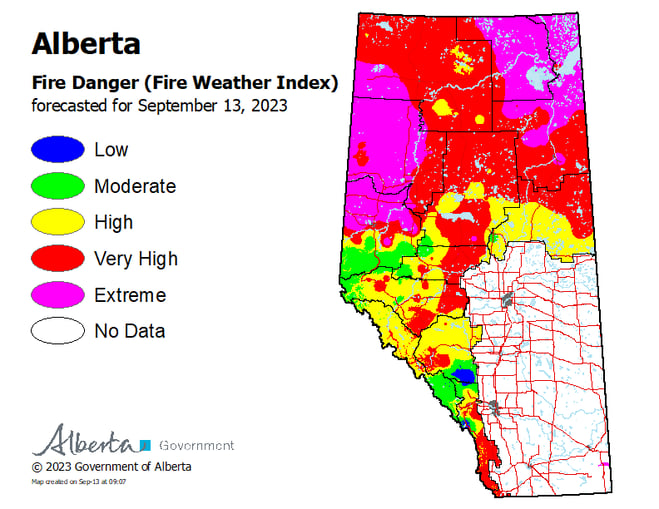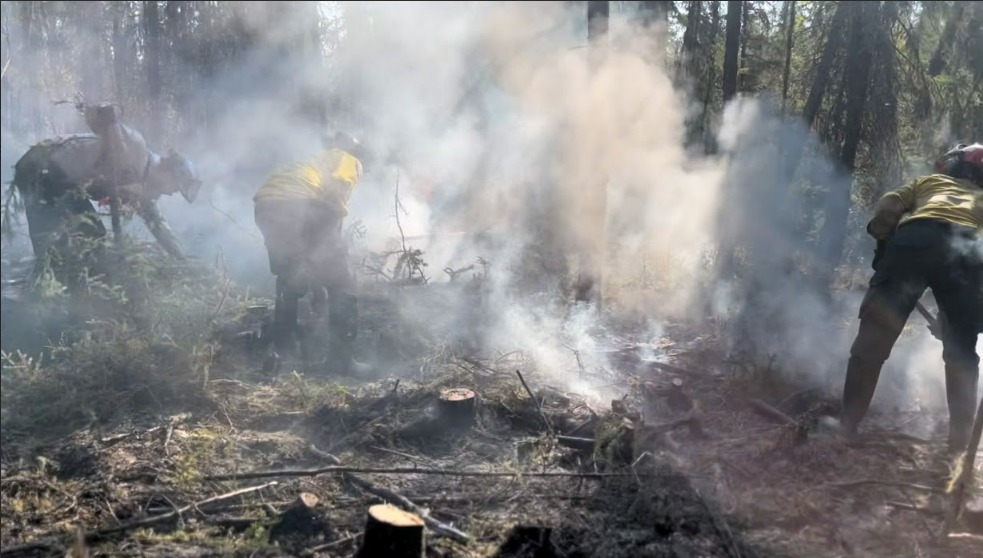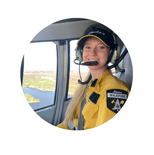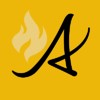
WILDFIRE DANGER
The wildfire danger south of Lake Athabasca is VERY HIGH and the wildfire danger north of Lake Athabasca is EXTREME within the Fort McMurray Forest Area.
A fire advisory remains in effect for the Fort McMurray Forest Area. See details below.
Please be very cautious when spending time outdoors, as conditions are dry and windy. Wildfires can ignite easily and spread quickly.
Report wildfires immediately by calling 310-FIRE (3473).

The forecasted fire danger map is updated daily around 3 pm.
EVACUATION ORDERS
Highway 5 is currently closed due to wildfire activity. Click here for more highway closure information.
The Regional Municipality of Wood Buffalo (RMWB) has declared a state of local emergency and issued an evacuation order for the community of Fort Fitzgerald. Click here for more information.
The Chief and Council of Smith's Landing First Nation has declared a state of local emergency and issued an evacuation order. Click here for more information.
The Town of Fort Smith has declared a state of local emergency and issued an evacuation order for residents within the municipality and surrounding areas. Click here for more information.
For information on Northwest Territories evacuations click here.
For more information and related links, please see Wood Buffalo Complex below.
SMOKY CONDITIONS
Due to the numerous wildfires in western Canada, smoky conditions will continue. Anyone with health concerns should visit Alberta Health Services or call 811 for health advice from Alberta Health Link. Before travelling check 511 Alberta for information the latest road conditions or closures. Visit Fire Smoke Canada to see where the smoke is coming from. To view wildfires on a map, download the AB Wildfire Status App or visit the Alberta Wildfire Status Dashboard.
WILDFIRE OF NOTE
Wood Buffalo Complex
(Previously Parks Canada Fire 7, Alberta Wildfire MNZ003, and NWT SS069)

Firefighters work to extinguish a hot spot (September 12, 2023).
To see the latest map of this wildfire, click here.
This wildfire is managed under unified command between Alberta Wildfire, the Government of the Northwest Territories, and Parks Canada from the incident command post in Fort Smith.
The Wood Buffalo Complex was last estimated at 485,159 hectares in size and is classified as OUT OF CONTROL, which means that the fire is still burning and is expected to grow.
When visibility allows, firefighters use multiple tools to measure distances and size. These tools have various accuracies and are subject to change. For up-to-date estimated distances from the fire to each community, please see attached map.
As of yesterday, 21 km of the northern fire perimeter is considered controlled. A controlled fire perimeter is the portion of fire perimeter that has received sufficient suppression action to ensure no further spread of fire. 93 km of the northern perimeter is considered contained. A contained fire perimeter is the portion of the fire perimeter that is not expected to spread given current resource commitments and forecasted weather and fire behavior conditions.
There are currently 320 personnel responding to the Wood Buffalo Complex, which includes 37 pieces of heavy equipment, 17 helicopters and 177 firefighters and structure protection firefighters. These numbers fluctuate as personnel leave the incident for much needed rest and new personnel and resources arrive.
Conditions
The Fort Smith area continues to be unseasonably warm and dry. Temperatures are approximately 7 degrees Celsius higher than the seasonal average. Yesterday, heavy smoke in the area significantly impacted helicopter operations. The smoke led to lower temperatures and higher relative humidity than forecasted and helped to suppress fire behaviour.
Today, similar smoky conditions are expected with temperatures in the mid 20 degrees Celsius and a relative humidity of 35 per cent. Light winds from the south are expected to increase by late evening with gusts of up to 30 km/h. Light showers are possible overnight.
The drought code remains over 1,100 and will remain at extreme levels until significant precipitation is received.
What is being done
Aerial operations were significantly impacted yesterday due to smoky conditions. As a result, crews used ground patrols to monitor the fire perimeter and worked to extinguish hot spots.
Thebacha: Crews patrolled the fire perimeter in this area and extinguished hot spots. The perimeter in much of the Connie’s Road and Foxholes Road area is considered contained due to the significant and ongoing firefighting efforts of crews. As residents of Fort Smith return to the community it is imperative that members of the public avoid this area. Please give our crews the space they need to work safely.
Fort Fitzgerald: Crews worked along the perimeter closest to Fort Fitzgerald to extinguish hotspots. Poor flying conditions meant that work was limited to areas accessible by ground. Work continues to secure the perimeter south and west of the community.
Hwy 5: Firefighters continue to patrol the eastern portion of the fire perimeter along Highway 5 for any remaining hot spots. As members of the community return, please be aware of crews working along the road – slow down and give them space to work as you pass. The RCMP are assisting with increased speed enforcement to ensure crew safety.
Perimeter line south of Fort Smith: Crews patrolled the perimeter south of Fort Smith closest to the community to ensure it remains controlled.
Heat-sensing scans continue to be completed nightly to help firefighters find and extinguish hot spots. The scans assign each heated area to a GPS coordinate, which crews use to zone in on the spots and take a “seek and destroy” approach, extinguishing them one-by-one. Crews working areas throughout the fire have been reporting 2-3 feet deep hot spots. Putting out spots this deep requires significant time and effort. Hotspots must be excavated by hand or with heavy equipment and extinguished with bucket support from helicopters and lots of water from hoses.
Do not fly drones near wildfires
Yesterday, fire management personnel received a report of a recreational drone flying within the wildfire NOTAM (Notice to Air Missions) area.
As community members return to the area, we understand that people may be curious about the changes to the landscape. However, flying drones (including those below 249 grams) above an active wildfire area is illegal and dangerous.
Flying drones over a wildfire endangers firefighting personnel and may cause firefighting operations to stop. Illegally flying a drone could result in fines of up to $15,000.
Re-entry
The Town of Fort Swift have begun the steps needed to lift the evacuation order, with essential service workers returning before the general public.
Details on re-entry can be found on the Town of Fort Smith's website.
The Government of the Northwest Territories has begun pre-registration for re-entry flights for residents of Fort Smith. Pre-registration for re-entry flights is now available for evacuees from Hay River, Kʼatlodeeche First Nation and Fort Smith. Evacuees from these locations can pre-register until 8:00PM on Thursday, September 14. Visit the Government of the Northwest Territories re-entry site to pre-register.
While the risk to Fort Smith has been reduced, there is still more work needed to secure the fire perimeter close to Thebacha, Bell Rock, Bordertown and Fort Fitzgerald before residents of those communities can return. Crews continue to work hard on suppressing the fire in these areas and are making good progress.
We are working with communities to plan for their re-entry but are not yet able to provide a firm date.
Reminder
The Town of Fort Smith continues to be under a STATE OF LOCAL EMERGENCY and remains under an EVACUATION ORDER. The order has been issued for public safety. If you are not an essential worked, please do not return until re-entry for the general public has been announced.
For more information on re-entry planning, please reach out to your community.
Road closures
- Highway 5 is currently CLOSED from Hay River to Fort Smith due to safety concerns and limited visibility. Visit NWT Highways for more information.
- Pine Lake Road from Bordertown to Peace Point remains CLOSED due to fire behaviour and active fire operations in the area.
Additional wildfire information
All other wildfires in Wood Buffalo National Park are being actively monitored and do not pose a risk to public safety at this time. Parks Canada will respond to these wildfires as required.
For information on other wildfires visit:
- Wood Buffalo National Park wildfire updates
- Northwest Territories fire information
- Alberta Wildfire Status
Report any wildfires or suspicious smoke:
- Alberta: 310-FIRE
- Northwest Territories: 1-877-NWT-FIRE
- Wood Buffalo National Park: 867-621-0136

FIRE ADVISORY IN EFFECT
A fire advisory is in effect for the entire Fort McMurray Forest Area due to continued hot and dry conditions which will increase the fire behaviour potential.
Under this advisory:
- Existing fire permits are still valid but may be suspended or cancelled if warm, dry weather continues
- The issuing or suspension of new permits is left to the discretion of a forest officer until conditions change
- Permits for the use of fireworks and exploding targets will not be issued.
Prohibited
Any burning without a valid fire permit, other than a campfire.
Allowed
- Safe wood campfires (including charcoal briquettes) in backcountry or random camping areas
- Safe wood campfires (including charcoal briquettes) on private lands and in provincial campgrounds
- Backyard fire pits
- Charcoal briquette barbeques
- Gas and liquid powered appliances (stoves and lanterns)
- Open flame oil devices (e.g., turkey deep fryers, tiki torches)
- Catalytic or infrared-style heaters
- Indoor wood fires
Remember to check the hot spots on your Off-Highway Vehicle (OHV) and remove debris before and after use.
Never leave a campfire unattended. Soak it, stir it and soak it again until cool to the touch to ensure it is extinguished.
If you see a wildfire, report it immediately by calling 310-FIRE.
The fire advisory will remain in effect until conditions improve.
FORT MCMURRAY WILDFIRE UPDATE
Since January 1, 2023 there have been 58 wildfires in the Fort McMurray Forest Area, burning a total of approximately 364,359 hectares (ha).
MWF021 was detected on May 27 and is located approximately 38 km south of Wood Buffalo National Park. This wildfire is classified as under control (UC) and is 14,760 ha in size. This wildfire was caused by lightning.
MWF023 was detected May 28 and is located near Birch Mountains Wildland Provincial Park. This wildfire is classified as under control (UC) and is 54,639 ha in size. This wildfire was caused by lightning.
MWF024 was detected May 28 and is located east of Marguerite River Wildland Provincial Park. This wildfire is classified as under control (UC) and is approximately 28,454 ha in size. This wildfire was caused by lightning.
MWF025 was detected May 28 and is located approximately 7 km north of Fort Chipewyan. This wildfire is classified as being held and is approximately 105,251 ha in size. This wildfire was caused by lightning.
This wildfire no longer poses a threat to the community of Fort Chipewyan, Allison Bay, Dog Head, or the Fort Chipewyan airport. Eighty per cent of the wildfire perimeter is controlled, which includes the entire south perimeter.
MWF038 was detected on June 29 and is located approximately 6 km north of the Slave Lake/Fort McMurray Forest Area border. This wildfire is classified as under control (UC) and is approximately 569 ha in size. This wildfire was caused by lightning.
MWF039 was detected on June 29 and is located within Birch Mountains Wildland Provincial Park but has crossed over into the Slave Lake Forest Area. This wildfire is classified as under control (UC) and is approximately 15,200 ha in size. This wildfire was caused by lightning.
MWF043 was detected on June 30 and is approximately 20 km southeast of Fort Fitzgerald. This wildfire is classified as being held and is approximately 130,805 ha in size. This wildfire was caused by lightning.
This wildfire is not currently moving any closer to Fort Smith or Fort Fitzgerald.
Mutual-aid wildfires:
MNZ001 is located on the south edge of the Alberta/Wood Buffalo National Park border. This wildfire is classified as being held and is approximately 2,595 ha.
PROVINCIAL WILDFIRE UPDATE
ON ALERT
Fire lookouts are on high alert constantly watching for smoke and firefighters in helicopters are assessing potential wildfire sightings, ready to respond to any new wildfires that may start.
Wildland firefighters urge everyone to be extremely cautious when out in the Forest Protection Area. Check your winter burns, and comply with fire bans and OHV restrictions.
.png?width=658&height=345&name=WF_Social-images%20(8).png)
CAMPFIRE SAFETY
Remember to check Alberta Fire Bans for fire advisories, bans or restrictions in your area or destination. If you are camping in a provincial or national park, check the rules and guidelines and be sure to follow them for your safety and the safety of other campers.
Safe wood campfires - should be within a metal, brick, or rock fire ring.
They are required to:
- be on rock, gravel, sand, or another non-combustible surface that extends at least one metre around the fire
- have a responsible person in attendance to keep fire under control at all times and extinguish before leaving
- have enough water on hand to extinguish the fire. Safe wood campfires on private lands include private land campgrounds and private land recreation areas.
Always let the fire burn down before you plan to extinguish it. Spread the embers within the fire pit, then add water or loose dirt and stir. Repeat until your campfire is cool to the touch. You should not be able to feel any heat from the ashes.
OHV SAFETY
If you plan on riding OHVs in the Forest Protection Area of Alberta, you can reduce the risk of your vehicle causing a wildfire by following these simple steps:
- Before you ride, clean out hot spots and remove debris from your machine.
- After riding through muskeg or tall grass, stop and remove any build-up from your machine.
- Carry firefighting equipment such as a small shovel, collapsible pail or fire extinguisher.
- Wash your OHV and keep it clean; do not wash in streams and creeks.
- Make sure your muffler and spark arrestor are working properly.
- Stop frequently. Take the time to knock debris from your machine’s hot spots. If the debris is smouldering, soak it, stir it, and soak it again to make sure it is extinguished.
For more information, see Off-highway vehicles: Wildfire prevention tips.
EXPLODING TARGETS AND FIREWORKS
The Forest and Prairie Protection Act and associated regulations applies to the shooting, ignition or detonation of exploding targets and fireworks on public lands and private lands located within the FPA.
A Forest Officer from the local forest area office may grant written permission to shoot, ignite or detonate exploding targets or fireworks in the FPA. Written permission of exploding targets and fireworks is based on current wildfire danger and managed on a case-by-case basis.
A fire advisory, restriction, ban or forest closure may prohibit or limit use of exploding targets and fireworks during high wildfire hazard situations within the FPA. Check Alberta Fire Bans or download the Alberta Fire Bans app for the latest information.
WILDFIRE DASHBOARD
The wildfire dashboard provides up-to-date wildfire information at the click of a button. This interactive tool displays important statistics on the number of active wildfires in the Forest Protection Area of Alberta, sizes, locations, suspected causes and more.
CONTACT

Websites:
- Alberta Wildfire
- Alberta Fire Bans
- FireSmart in Alberta
- Alberta Emergency Alerts
- Air Quality Health Index
- Wildfire Smoke and Your Health
- 511 Road Reports
- Emergency Preparation
Social media:
Join the conversation on
Apps:
Alberta Wildfire App for Apple or Android and Alberta Fire Bans App for Apple or Android.
